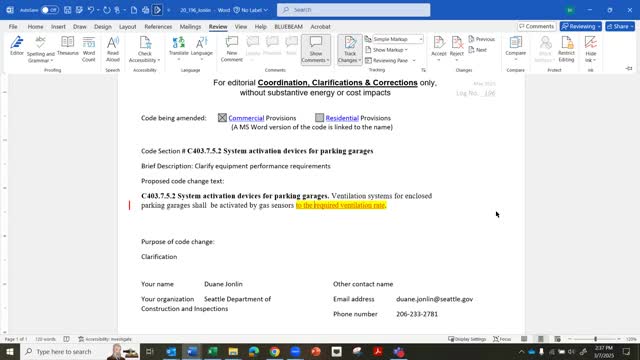Seattle approves new gas sensor ventilation requirements for parking garages
March 08, 2025 | Building Code Council, Governor's Office - Boards & Commissions, Executive, Washington
This article was created by AI summarizing key points discussed. AI makes mistakes, so for full details and context, please refer to the video of the full meeting. Please report any errors so we can fix them. Report an error »

The SBCC WSEC-C TAG Meeting held on March 7, 2025, focused on significant updates to ventilation and energy recovery standards in Washington's building codes. The meeting, attended by various stakeholders, aimed to refine existing regulations to enhance safety and efficiency in enclosed parking garages and multifamily dwelling units.
The first major discussion centered on the activation of ventilation systems in enclosed parking garages. It was proposed that these systems should be triggered by gas sensors to ensure compliance with the International Mechanical Code (IMC). The group unanimously agreed to modify the existing language to include a reference to Section 404 of the IMC, which outlines the required ventilation rates. A motion to accept this modification was passed without opposition.
Subsequent discussions addressed the effectiveness of ballast ventilation systems in multifamily units, with a proposed increase in sensible recovery effectiveness from 60% to 67%. Local engineers confirmed that this change would not incur additional costs, as these systems are already common practice. The meeting also included minor editorial adjustments to clarify existing code language.
A notable point of contention arose regarding exceptions for climate zones within the code. Participants debated the relevance of climate zone specifications, particularly the elimination of exceptions for climate zone 4 and 5, which do not apply to Seattle. After some deliberation, a friendly amendment was proposed to remove these climate zone specifications, which was accepted.
The meeting concluded with a motion to approve the proposed changes as modified, which was met with unanimous support. The adjustments aim to streamline the code, making it more understandable while ensuring that it aligns with current practices and standards.
Overall, the meeting underscored the collaborative effort to enhance building safety and energy efficiency in Washington, with a focus on practical applications and adherence to established codes. The next steps will involve finalizing these modifications and preparing for their implementation in future building projects.
The first major discussion centered on the activation of ventilation systems in enclosed parking garages. It was proposed that these systems should be triggered by gas sensors to ensure compliance with the International Mechanical Code (IMC). The group unanimously agreed to modify the existing language to include a reference to Section 404 of the IMC, which outlines the required ventilation rates. A motion to accept this modification was passed without opposition.
Subsequent discussions addressed the effectiveness of ballast ventilation systems in multifamily units, with a proposed increase in sensible recovery effectiveness from 60% to 67%. Local engineers confirmed that this change would not incur additional costs, as these systems are already common practice. The meeting also included minor editorial adjustments to clarify existing code language.
A notable point of contention arose regarding exceptions for climate zones within the code. Participants debated the relevance of climate zone specifications, particularly the elimination of exceptions for climate zone 4 and 5, which do not apply to Seattle. After some deliberation, a friendly amendment was proposed to remove these climate zone specifications, which was accepted.
The meeting concluded with a motion to approve the proposed changes as modified, which was met with unanimous support. The adjustments aim to streamline the code, making it more understandable while ensuring that it aligns with current practices and standards.
Overall, the meeting underscored the collaborative effort to enhance building safety and energy efficiency in Washington, with a focus on practical applications and adherence to established codes. The next steps will involve finalizing these modifications and preparing for their implementation in future building projects.
View full meeting
This article is based on a recent meeting—watch the full video and explore the complete transcript for deeper insights into the discussion.
View full meeting
